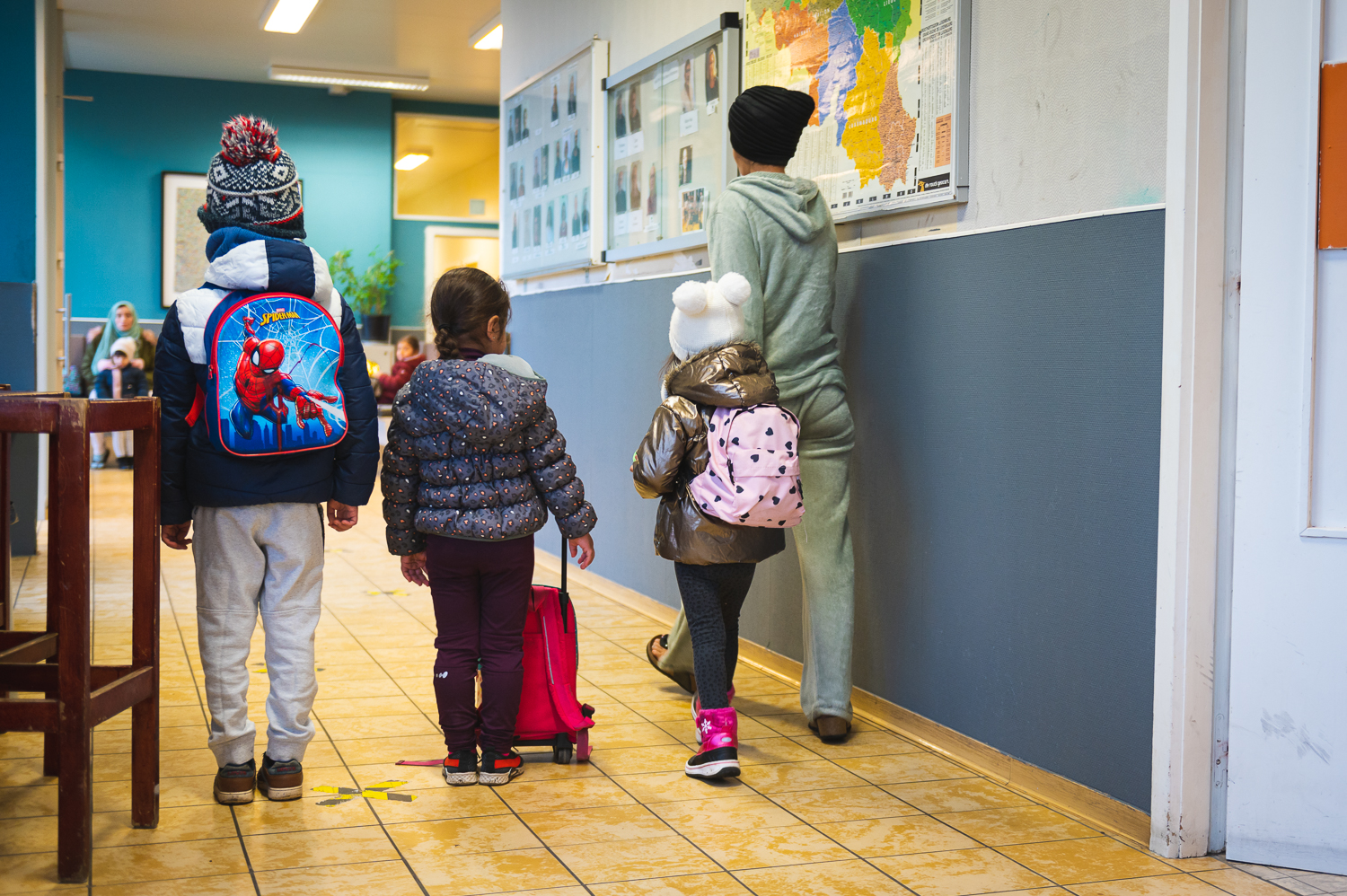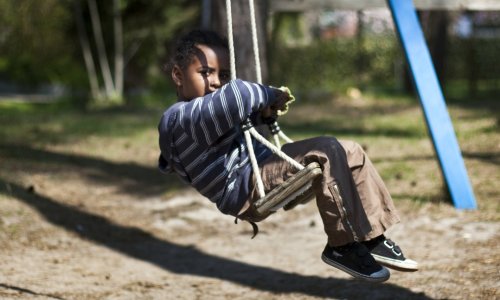Reception of applicants for international protection
Worldwide, millions of people are fleeing war or persecution, for example. Some end up in Belgium, apply for international protection and need a safe place and a temporary home. At the request of the government (Fedasil), Belgian Red Cross-Flanders helps provide for their reception in collective reception centers. We do so with attention to the needs of the shelter residents and in harmony with the environment.
Providing humane shelter as government helper
Providing humane shelter to people on the run is fully in line with the fundamental principles of the Red Cross. Since 1989, Belgian Red Cross-Flanders has organized part of the reception of applicants for international protection in Belgium as an auxiliary to the government.
In our shelters, we offer residents a temporary home for as long as the asylum procedure lasts. The 4B's summarize the reception: bed, bath, bread and guidance. In addition to the primary needs, residents are assisted in their asylum procedure. We provide objective and correct information, also about the possibility of voluntary return. Moreover, we encourage and support them to actively work on their future. We strive for a humane stay for all residents. In our reception centers, we encourage participation and interaction by involving them in the daily operations of the reception center. We organize language classes, leisure and sports activities. If necessary, we provide psychological and medical counseling. We also work to integrate our centers into their surroundings by encouraging contacts between the residents,the neighborhood and partner organizations. In this we are supported by our enthusiastic volunteers.
Guardianship of unaccompanied minors
Among the refugees there are also minors who arrive in Belgium without parents or legal guardians. In addition to reception for applicants for international protection, we also offer guardianship of unaccompanied minors. These unaccompanied minor refugees are very vulnerable. It goes without saying that we offer them specialized care, support and protection.

© Yngwie Scheerlinck
Reception in Belgium
How is the reception of applicants organized in Belgium?
- The reception of applicants takes place in collective and individual reception structures.
- Together, they make up the reception network. Fedasil is the Federal Agency for Reception of Applicants for International Protection and coordinates the network.
- Belgian Red Cross-Flanders/Croix Rouge de Belgique Communauté Francophone is Fedasil's largest shelter partner and operates collective shelters on behalf of the government. Other shelter partners include Caritas, Samusocial, private providers (non-exhaustive).
- There are also individual shelters in Belgium. These are houses run by an OCMW or an NGO. Only people who meet certain criteria can stay at an individual reception location. Belgian Red Cross-Flanders itself does not organize individual reception.
- How many applicants are there in Belgium and how many shelters are there? You can find this information through the site of Cijfers | Fedasil.
Why does Belgian Red Cross-Flanders organize shelter?
The Red Cross has been committed to helping applicants for years - nationally and internationally. In 1989, the Belgian government asked the Red Cross to cooperate in receiving them in Belgium. Thereupon, the Belgian Red Cross and the Belgian government entered into an agreement for the reception of petitioners.
This agreement sets out how we organize the reception and who has what responsibilities. For example, the government bears the costs - up to a predetermined amount. Belgian Red Cross-Flanders does not use its own resources or raise public funds for the reception of applicants for international protection.
What exactly does "shelter" in a shelter mean?
In a shelter, residents receive "material assistance." That means they receive shelter, meals, clothing and access to sanitation. This support is often described as "bed-bath-bread." They also receive counseling, the fourth 4 B in addition to "bed-bath-bread." This includes guidance in the procedure for requesting international protection in addition to psychosocial and medical support where needed.
A resident is entitled to material assistance if he has a pending procedure requesting international protection. This right is opened when making a request for international protection in Brussels to the competent authority (Immigration Office) and starts as soon as an applicant requests reception and is assigned by Fedasil to a reception center. This right runs until the procedure is completed and the occupant receives (temporary) protection or not from the Belgian authorities.
Opening a new shelter
Who decides where to put a shelter?
The decision to open a shelter somewhere lies with the federal government. Depending on the needs, new sites or buildings may be sought.
With the possible arrival of a reception center in a municipality, the Secretary of State for Asylum and Migration contacts the mayor, who informs them.
How does Belgian Red Cross-Flanders work with the municipality?
Once the Belgian Red Cross-Flanders is designated to operate the new shelter, we will schedule a meeting with all parties involved. We feel it is important to establish positive and constructive cooperation with all parties.
There is coordination on the construction and opening of the shelter, a communication plan and strategy, cooperation with various other municipal actors (fire department, police, civil service, schools, etc.).
How will nearby residents be informed about a new shelter?
The Belgian Red Cross-Flanders and the municipality/cities together draw up a communication plan. It is important that local residents be correctly and fully informed about the arrival of a shelter.
Communication can then take place through both the Belgian Red Cross-Flanders and township channels. In consultation with the municipality or city, it is determined who takes on which task.
The organization of the shelter
How is the infrastructure of a shelter organized?
A shelter is a site/building set up as a residential and living environment for a group of people. This means that spaces are provided for both residents and staff.
What do residents receive in a shelter?
Belgian Red Cross-Flanders provides a shelter with the four Bs: bed, bath, bread and guidance. That means giving them a roof over their heads, the ability to provide personal hygiene, three meals a day, and guidance and support during their stay at the shelter.
How is living together in a shelter organized?
Living in a collective shelter can be challenging for residents. As a resident, you live in community with people from different continents, from other cultures and with a diversity of languages. Therefore, rules and agreements are needed. These are contained in by-laws. An information brochure informs each newcomer in their own language about their rights and duties and the house rules.
In organizing shelter, we allow residents as much privacy as possible in their temporary home. , But not everyone has their own room. The centers' infrastructure does not allow for that. Singles usually share a women's or men's room. A family gets its own room.
The residents of the shelter
Who stays in a shelter?
In a shelter, we always try to have a good combination of groups. For example, there will be a mix of singles and families staying there. Some centers also host unaccompanied minors. This requires specialized supervision and infrastructural possibilities to give these young people their own space, not mixed with adult residents. . We are also committed to a good mix of nationalities. Often in a reception center you have more than 25 different nationalities under one roof.
Can anyone choose where to stay?
Applicants for international protection decide whether they will live independently or need shelter in a collective shelter structure. Residents cannot choose which shelter they will stay in. Available places determine where they will end up. When a bed becomes available in a reception structure, the Fedasil Dispatching Service assigns this place to an applicant for international protection. The allocation is tailored as much as possible to the needs of the resident, such as specific medical needs or in function of family reunification. The right to shelter is for the duration of the asylum procedure. Once the resident has a right of residence, he or she is expected to leave the shelter.
What do applicants do during their stay at the shelter?
Initially, we offer residents the rest and time they need to feel at home and safe. After that, we look at a resident's needs and questions from the guidance point of view. Commitment to self-reliance of residents in the new living environment is an important principle. Adult residents are always given the opportunity to take language classes and underage residents we try to start regular education as soon as possible. There are also many other courses for adult residents to take in order to develop or strengthen their competencies. Residents can also find their way into the job market or volunteer with an organization.
Shelter staff
Who works in a shelter?
In a shelter we work from an integral approach: each supervisor follows up with residents, organizes activities and helps with the practical and logistical organization of the center. This keeps everyone involved in all aspects of reception.
Employees with particular expertise, such as medical, logistics, procedure, were hired for certain tasks at the center.
A center manager, along with one or more deputies, leads the center and the team.
What does a volunteer do at the shelter?
Volunteers are always welcome at a shelter. They can be used for a wide variety of tasks, from doing chores and repairing bicycles to leading discussion groups or playing soccer with residents. The shelter always examines with a candidate volunteer what his skills are and what needs the shelter has.
The shelter in its environment
Does a shelter also work with other organizations and the neighborhood?
Of course. A shelter cannot do everything alone and is part of society. Therefore, we also rely on other organizations and partners who have their own expertise. Such is the case for medical assistance with external healthcare providers, or for catering at the shelter.
But these partnerships extend beyond that. The shelters engage with (local) organizations that can play a supportive role in order to create targeted and fruitful interactions.
The shelter also strives to have strong roots in the neighborhood. We strive for optimal communication and positive interaction. From their open identity, the shelter aims to encourage residents' interaction with the neighborhood. We organize activities for the neighborhood and its residents and keep interested parties informed about the ins and outs of the shelter through a Facebook page.
How can I help?
Is the shelter looking for specific items or clothing?
This is hard to say in advance. If a shelter is looking for certain goods for its operation or to support its residents, it will launch a call for them through its own Facebook page.
Offering items to the shelter spontaneously yourself is not a good idea because the center will not always be able to use them.
Are you interested in working at the shelter?
We may also be looking for colleagues in the center near you, such as handyman/woman, logistician, (night) supervisor, medical supervisor, administrative assistant, deputy manager and center manager.
Apply today Apply through the job site at Belgian Red Cross-Flanders.
Would you like to become a volunteer at a shelter?
You certainly can! We are always looking for helping hands. Apply by briefly introducing yourself and indicating what you would like to do, via email at opvangasielzoekers@rodekruis.be.
You can contact a shelter near you directly. Contact information for all shelters can be found here.
Are you more interested in how your neighborhood shelter operates?
Each shelter has its own Facebook page. There they post updates from the center, announce interesting events, and you can find any calls.

